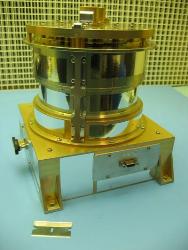Mar 12 2010
The outer layers of Earth's atmosphere hold many secrets yet to be uncovered and three scientific instruments will fly soon on the FASTSAT-HSV01 satellite and seek to uncover them to benefit us here on Earth. Known as MINI-ME, PISA and TTI, these instruments recently passed a series of important final tests to prove their readiness for spaceflight.
 MINI-ME, acronym for Miniature Imager for Neutral Ionospheric atoms and Magnetospheric Electrons, is a low energy neutral atom imager which will detect neutral atoms formed in the plasma population of the Earth's outer atmosphere to improve global space weather prediction.
MINI-ME, acronym for Miniature Imager for Neutral Ionospheric atoms and Magnetospheric Electrons, is a low energy neutral atom imager which will detect neutral atoms formed in the plasma population of the Earth's outer atmosphere to improve global space weather prediction.
These instruments were conceived and built at NASA's Goddard Space Flight Center in Greenbelt, Md., and were integrated to the satellite and tested at NASA's Marshall Spaceflight Center, Huntsville, Ala.
MINI-ME, acronym for Miniature Imager for Neutral Ionospheric atoms and Magnetospheric Electrons, is a low energy neutral atom imager which will detect neutral atoms formed in the plasma population of the Earth's outer atmosphere to improve global space weather prediction. Low energy neutral atom imaging is a technique first pioneered at Goddard which allows scientists to observe remotely various trapped charged particle populations around Earth that we would normally only be able to observe in-situ through direct instrument contact with the particles.
Michael Collier, Principal Investigator for the MINI-ME instrument at NASA Goddard said, "The satellite has gone through vibration, thermal, and Electromagnetic Interference (EMI) tests and everything looks great. The MINI-ME instrument is performing as expected."
PISA is an acronym for the Plasma Impedance Spectrum Analyzer, which will test a new measurement technique for the thermal electron populations in the ionosphere, and their density structuring, which can interfere with or scatter radio signals used for communication and navigation. PISA will tell scientists on Earth when and where the ionosphere becomes structured or turbulent. That will give us better predictions of how space weather will affect GPS signals.
Doug Rowland, PISA's Principal Investigator at NASA Goddard said, "PISA has completed the same tests that the Mini-ME endured and has just passed powered Electromagnetic Interference Test. PISA is on track for spacecraft to be packed up and delivered to the launch site." The EMI, vibration and thermal testing are critical tests for all instruments and satellites before they're loaded aboard a rocket and put into orbit.
The Thermospheric Temperature Imager, or TTI, will provide the first global-scale measurements of thermospheric temperature profiles in the 56-168 mile (90-270 km) region of the Earth's atmosphere. The temperature profile sets the scale height of the thermosphere which determines the density at orbital altitudes and therefore the aerodynamic drag experienced by military spacecraft.
John Sigwarth, TTI's Principal Investigator at NASA Goddard, said "The TTI survived the satellite launch vibration levels, being blasted with radio waves, and the TTI had a great thermal vacuum test. We were able to characterize the operation of the instrument in space-like environments and the TTI is ready for launch. We are eagerly anticipating obtaining great data from orbit."
Electromagnetic Interference or EMI testing is done to ensure that powerful ground-based communications and radar systems do not cause interference on the satellite or instrument systems.
Vibration testing is an important part of the testing process, because when the rocket carrying the satellite lifts off and travels through Earth's atmosphere it experiences intense vibrations. Successful vibration testing assures scientists and engineers that their instrument will remain intact and fully functional after launch.
Thermal testing is also critical, because of the extreme temperatures in space. Scientists need to be sure that the instruments will maintain function at extreme temperatures, from the extreme heat the rocket carrying the satellite will experience during launch and when it travels through Earth's atmosphere into the cold void of space.
"With the completion of the last phase of environmental testing of the integrated FASTSAT-HSV01 spacecraft, our team is focused on readying the satellite and its six science and technology instruments, for its near term shipment to Kodiak, Alaska, and for an on time launch no earlier than May 28, 2010," said FASTSAT Project Manager Mark Boudreaux at NASA Marshall.
"FASTSAT-HSV" means "Fast, Affordable, Science and Technology Satellite, Huntsville" The development, integration, test and operations of the three instruments is a collaborative effort between NASA Goddard, NASA Marshall, and the U.S. Naval Academy, Annapolis, Md.
FASTSAT-HSV01 will be flying a total of six instruments approved by the U.S. Department of Defense (DoD) Space Experiments Review Board multi-spacecraft/payload mission named STP-S26, which is executed by the DoD Space Test Program (STP) at the Space Development and Test Wing (SDTW), Kirtland Air Force Base, N.M. which is a unit of the Air Force Space and Missile Systems Center. The mission was designated S26 to correspond to the 26th small launch vehicle mission in STP's more than 40 year history of flying DoD space experiments. The mission will launch four satellites and three cubesats into low earth orbit.
Source: http://www.nasa.gov/